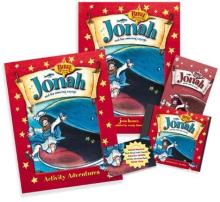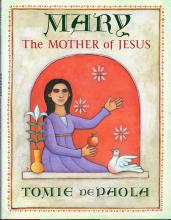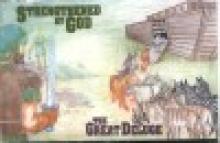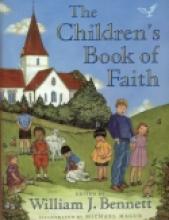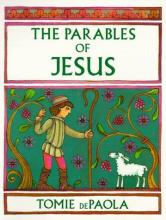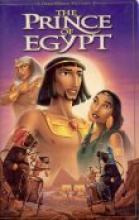Bible Stories
Jonah and His Amazing Voyage (Bible Adventure Club)
Set sail on a stormy sea with Jonah and His Amazing Voyage as your young children learn about Bible stories in this light-hearted set from the Bible Adventure Club series.
Each kit includes a hard cover full-color picture story book, activity book, read-along audio cassette, interactive CD-Rom, and parents guide. The picture book is a simple retelling of the story of Jonah to appeal to younger children with bold, colorful, and cartoon-like illustrations. The audio cassette is a dramatized version of the story with original music to listen to while reading along with the book. The activity book includes fun facts, projects, mazes, and more. The interactive CD-Rom includes an animated story, original song, coloring book, word search, matching, puzzles, quiz game and light up puzzle (a scrambled puzzle that lights up when the squares are in order.). Some activities offer different levels of play.
Because of the light-hearted approach and the types of activities, this kit is designed for younger children. My five-year-old and eight-year-old daughters have enjoyed listening to the story many times as well as playing the many creative learning activities on the CD-Rom. Since there are a variety of activities on the CD-Rom and in the activity book, a wide range of younger children can enjoy this kit. Jonah and His Amazing Voyage is just one from a series of Bible Adventure Club kits. Other kits include Other kits include Creation:God's Wonderful Gift, Jesus:the Birthday of the King, Noah and the Incredible Flood, and David and his Giant Battle.
Mary, the Mother of Jesus
This is a very nice and very Catholic book about Mary for small children. But don't let its simplicity fool you - there is a great deal for older ones as well. There is a two page "chapter" on each of the following topics: The Presentation of the Child Mary at the Temple, The Betrothal of Joseph and Mary, The Annunciation, The Visitation, The Birth of Jesus, The Presentation of the Boy Jesus in the Temple, The Adoration of the Magi, The Flight into Egypt, The Boy Jesus in the Temple, The Marriage at Cana, The Ministry (of Jesus), Mary's Solitude (the Crucifixion), The Coming of the Holy Spirit, Mary is Taken to Heaven, and a final picture of The Queen of Heaven. Each "chapter" has one or two illustrations - in the Tomie de Paola style of course - a short verse from the Liturgy of the Hours and a simple retelling of the story.
New Catholic Picture Bible
Father Lovasik includes many more stories in this work than Tomie de Paola's work. The pictures are more traditional (although not fine art), yet the stories are still short enough to make this a good choice for preschoolers as well. He explains parts of the Bible in light of our Catholic tradition within the story. For example, in the story "Jesus Appears to the Apostles" Fr. Lovasik explains what Jesus said to the apostles with the following quote:
"In these words Jesus gave the apostles the power to forgive sins, which He had promised them. This power Jesus wished to remain in His Church forever. The apostles passed it on to their successors–the bishops of the Catholic Church. This power is exercised by the priest in the Sacrament of Penance."
Some may appreciate his "additions" to the stories, others may find it a little confusing. The book also contains the Stations of the Cross and photos from the Holy Land.
Available from many sources including those listed below.
Strengthened by God/The Great Deluge
The Children's Book of Faith
The Medicine of God
45 minutes, audio cassette
The Miracles of Jesus
This book is a beautiful way to help your children learn to know and love Jesus. With many simple pictures (but nicely done) and just enough details of the story, Tomie de Paola relates how Jesus helped others while he was on earth. Stories include: The Wedding at Cana, The Catch of Fishes, The Calming of the Storm, The Loaves and The Fishes, Jesus Walks on the Water, The Paralyzed Man, The Centurion's Servant, Jesus Heals the Lepers and The Raising of Lazarus. (13 stories altogether) My children love to hear about how good Jesus is and how much he loves them. This book is a really nice way of reinforcing that idea.
The Parables of Jesus
In a similar manner to The Miracles of Jesus, Tomie de Paola presents seventeen of Jesus' parables. This book makes them very accessible to small children and may even be the start of some interesting little discussions with your children about why Jesus told these stories. Some of the text of the parables is very brief.
The Prince of Egypt
I admit, our family went to see The Prince of Egypt because of William Donahoe's recommendation. The Catholic League plugged the newly-released animated picture on the story of Moses in its newsletter as well as in an Internet message. So we joined my family at Christmas in a rare trip to the theater, along with my dad (who was going to see it because Chuck Colson had recommended it).
When we emerged from the theater, all of us agreed that there was more reason to like this film than the facts that a.) it was completely clean b.) and it was not by Disney.
I had been told of the technical perfection of the animation and special effects. This is true - the film is stylistically executed by DreamWorks with the perfection of any Disney movie. The parting of the Red Sea is spectacular. It has its share of chases, escapes, and comic moments, with strong female characters and funny animals. The story is simple to follow - so clear that my toddler son burst into tears when baby Moses had to leave his mommy to be adopted by a strange lady. I had expected all these things.
But I wasn't expecting any more than an exercise in clean filming of a token Biblical story to please the Christian market. Prince was more than that. Here's three reasons to go see the film that have nothing to do with the political battle over children's movies.
First, Prince is racially truthful. This is the first Biblical movie I have seen in which none of the characters - none - were Caucasian. Personally I am tired of depictions of our Biblical fathers and mothers that insist on giving them fair skin and sometimes blue eyes. Both the Hebrews and the Egyptians in Prince have the bone structure and skin color of their races, which I found refreshingly (not politically) correct. Aren't the Jews and Africans sometimes right when they accuse American Christians of making the Gospel into "a white man's story?" Certainly these are the images we usually give our children. Prince was a definite step in the right direction.
The filmmaker's choice to tap the heritage of the black community in using a music style inspired by Gospel spirituals was wise and effective. For its audience of children, it provided a further link between the Biblical characters and the African heritage. The Hebrew songs - particularly the children's hymn which heralds the day of Israel's freedom - were wonderful touches. My personal favorite was "Through Heaven's Eyes," the song of Jethro, Moses' future father-in-law, done in Arabian style.
Second, there was the undercurrent of a pro-life message. The catalyst of Moses' transformation from a selfish prince of Egypt who never looks twice at his servants to the deliverer of Israel is when he discovers that his "father," the Pharaoh, commanded the slaughter of the infant Hebrew boys. His father justifies this as population control: "the Hebrews were too numerous." Moses, who can't imagine being related to slaves, begins to feel compassion first for these countless baby victims, whom he narrowly escaped joining. A sense of the enormity of the crime is overwhelming in different parts of the film. While not explicit, a pro-life message comes through. The last line of the film "Deliver us!" became for me a personal prayer for an end to our nation's holocaust.
Third, the movie shows clearly the effects of the most deadly of sins - pride. This film underscores the fact that the bulk of the plagues upon Egypt were the result of one man's selfishness and unwillingness to change - the Pharaoh Rameses. What makes this moral tale so believable is that the film explores the character of the hard-hearted Pharaoh in his boyhood friendship with Moses. "Don't be the weak link in the chain," Rameses' father tells him, unfairly punishing him for things he didn't do. The fact that Moses truly loves his foster brother and has compassion for his internal struggle even as the two face off as adults raises the caliber of the storyline. Moses begs Pharaoh to yield for the sake of the Egyptians suffering from the plagues, but Rameses, tormented by the sores and pests of the plagues himself, remains bitter and unyielding. He has lost the ability to feel compassion for anyone else. When he announces that the slaughter of Hebrew children will begin again, he brings down the plague of the death of the first-born upon himself. Faced with unwittingly causing the death of his young son, he temporarily agrees to let the Hebrews go. The stark portrayal of the effects of mortal sin has probably never been rendered to this depth in cartoon form before.
Having seen the movie, I would nominate it for an Academy Award. And along with William Donahoe and other Christian leaders, I can now say that I certainly hope that the movie industry makes more movies like Prince of Egypt (how about a sequel?). If you go to see Prince of Egypt, you'll "send a message to Hollywood," but you and your family will enjoy yourself as well.
Rated PG, 99 minutes
Executive Producer: Jeffrey Katzenberg
Director: Brenda Chapman, Steve Hickner and Simon Wells
Featuring the voice talents of: Val Kilmer, Ralph Fiennes, Sandra Bullock and Michelle Pfeiffer
Regina Doman is the author of The Shadow of the Bear: Snow White and Rose Red Retold, reviewed on this site and the mother of five children. She writes from Front Royal, VA.

